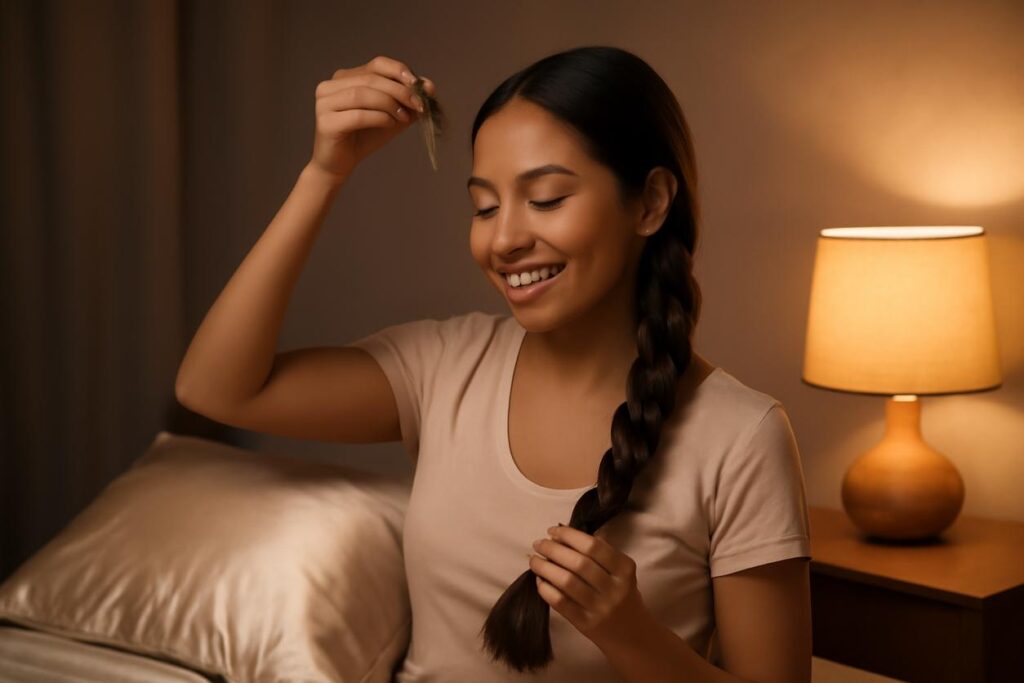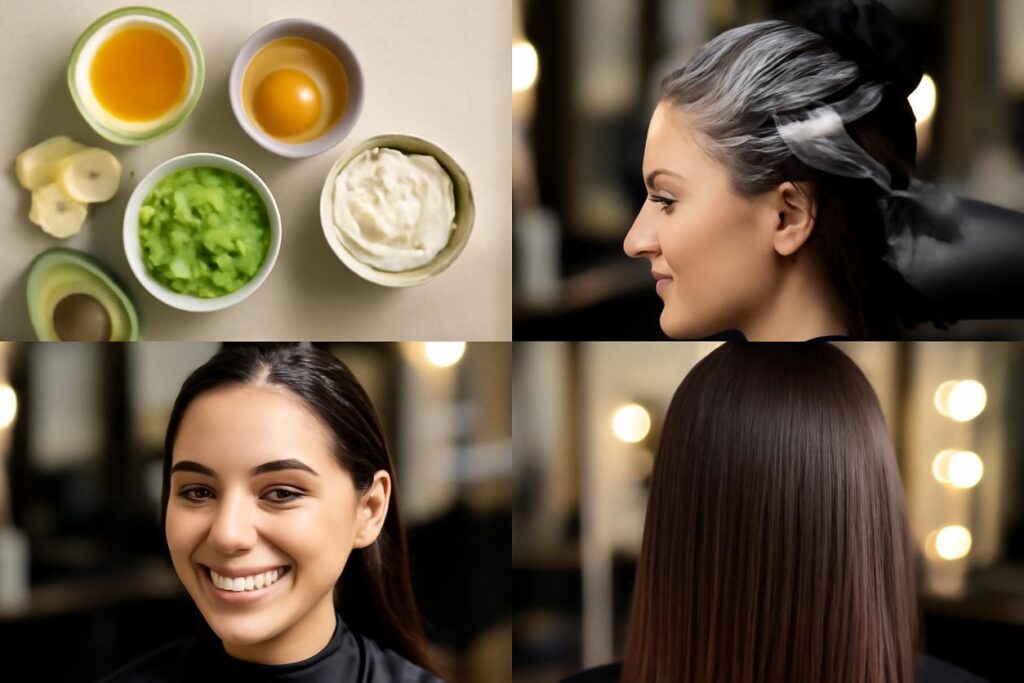The Ultimate 2025 Guide to Overnight Hair Care: Wake Up to Healthier, Happier Hair
Do you ever go to bed with decent hair only to wake up to a tangled, frizzy, or lifeless mess? You are not alone. The hours we spend sleeping are often overlooked in our beauty regimens, yet they present a golden opportunity for hair repair and protection. This guide is your complete resource for building a simple and effective overnight hair care routine. Forget complicated processes; we are focusing on low-effort strategies that deliver maximum results, helping you wake up with healthier, more manageable hair every single day.
By leveraging the power of your sleep cycle, you can protect your hair from damage, boost moisture, and set yourself up for a great hair day, all with minimal effort. This comprehensive guide will walk you through everything you need to know, from identifying your hair’s unique needs to mastering protective styles and creating a long-term plan for lasting hair health.
Table of Contents
- Why Your Hair Needs a Night Shift: The Science of Overnight Hair Care
- Step 1: Identify Your Hair Type and Overnight Needs
- Step 2: Your Pre-Sleep Checklist for Success
- Easy DIY Overnight Treatments and Recipes
- Step 3: Protective Bedtime Styles for Every Texture
- Step 4: Pillowcases, Wraps, and Bedding Choices That Reduce Damage
- Step 5: Scalp Night Rituals for Growth and Health
- Step 6: Morning Steps to Preserve Overnight Results
- Weekly and Monthly Night Routines for Long-Term Gains
- Common Nighttime Mistakes and How to Correct Them
- Reference Notes and Further Reading
Why Your Hair Needs a Night Shift: The Science of Overnight Hair Care
While you sleep, your body is hard at work in a state of repair and regeneration. This natural cycle extends to your hair and scalp. An effective overnight hair care routine works in harmony with this process, offering three primary benefits:
- Damage Prevention: Tossing and turning on a traditional cotton pillowcase creates significant friction against your hair cuticles. This friction can lead to frizz, tangles, and even breakage. A proper nightly hair routine minimizes this physical stress.
- Moisture Retention: Sleep offers an uninterrupted 7-9 hour window for treatments to deeply penetrate the hair shaft. Unlike daytime treatments, overnight masks and oils work without being disturbed by environmental factors like sun or wind, allowing for maximum absorption and hydration.
- Time Efficiency: For busy adults, a nightly routine is the ultimate life hack. It shifts intensive treatments to your sleeping hours, freeing up your morning schedule. You are essentially achieving better hair health with almost no active time commitment.
Step 1: Identify Your Hair Type and Overnight Needs
The foundation of any successful overnight hair care strategy is understanding what your unique hair type needs. Different textures and conditions require different approaches to maintain their health while you sleep. For a deeper understanding of your strands, you can review this overview of hair structure.
Decoding Your Hair’s Nightly Requirements
- Fine or Thin Hair: Your primary goal is to prevent tangles and avoid weighing the hair down. Focus on volume preservation. Heavy oils and creams are not your friend.
- Thick or Coarse Hair: Your hair can handle richer products. The main objective is to lock in moisture, control frizz, and ensure hair is deeply conditioned.
- Wavy or Curly Hair: The key is to preserve your curl pattern, fight frizz, and maintain moisture. Protective styles that do not stretch or flatten curls are essential.
- Coily or Kinky Hair: This hair type is the most fragile and prone to dryness. Your overnight routine must prioritize intense moisture retention and protection against breakage from friction.
- Oily Scalp and Hair: Focus on scalp health. Avoid heavy products near the roots. You might benefit from a dry shampoo application before bed to absorb excess oil overnight.
- Dry or Damaged Hair: Your hair needs all the moisture and protein it can get. Overnight is the perfect time for deep conditioning treatments and sealing oils to repair and rehydrate.
Step 2: Your Pre-Sleep Checklist for Success
Before you begin your routine, having the right tools on hand makes the process quick and seamless. You do not need a lot to build a powerful overnight hair care kit.
- Wide-Tooth Comb or Detangling Brush: To gently remove knots without causing breakage.
- Gentle Hair Ties: Think silk or satin scrunchies or spiral hair ties. Avoid tight elastics with metal parts, which can snag and break strands.
- Silk or Satin Pillowcase, Bonnet, or Scarf: This is a non-negotiable for reducing friction.
- Leave-in Conditioner or Hair Serum: A lightweight product to add a final layer of moisture or frizz control.
- Lightweight Hair Oil: Such as argan, jojoba, or grapeseed oil to seal the hair cuticle.
Easy DIY Overnight Treatments and Recipes
You don’t need expensive products to give your hair a nourishing boost. These simple, all-natural treatments can be prepared in minutes and work their magic while you rest.
Hydrating Aloe Vera and Coconut Oil Mask
Perfect for dry, dull, or frizzy hair, this mask is a moisture powerhouse.
- Ingredients: 2 tablespoons of pure aloe vera gel and 1 tablespoon of melted coconut oil.
- Instructions: Mix well and apply to your hair from mid-lengths to ends, avoiding the scalp if you have oily hair. Secure your hair in a loose bun or braid and cover with a shower cap or bonnet to protect your bedding. Wash out in the morning.
Strengthening Green Tea and Honey Rinse
This treatment is great for strengthening strands and soothing the scalp.
- Ingredients: 1 cup of cool, brewed green tea and 1 teaspoon of honey.
- Instructions: After detangling, spritz or pour the mixture through your hair, focusing on the scalp and ends. Let it sit for a few minutes before putting your hair up in a protective style. It is light enough that for many hair types, it does not need to be rinsed out in the morning.
Step 3: Protective Bedtime Styles for Every Texture
How you wear your hair to bed is one of the most critical components of overnight hair care. The goal is to minimize tangles, prevent breakage, and preserve your hairstyle.
For Straight and Wavy Hair
- The Loose Braid: A single, loose braid is a classic for a reason. It prevents tangles without creating a strong wave pattern. Start the braid low, behind your neck, to avoid tension.
- The Loose Top Knot or Bun: Pile your hair loosely on top of your head and secure it with a scrunchie. This keeps your ends protected and can help preserve volume. Ensure it is not tight, as tension can cause breakage.
For Curly and Coily Hair
- The Pineapple: This is a favorite in the curly community. Gather your hair into a very high, loose ponytail on top of your head, allowing your curls to cascade down. This protects the curls from being crushed while you sleep.
- Twists or Braids: For tighter curl patterns, sectioning the hair into several large, loose twists or braids can be more effective at preventing tangles and shrinkage.
- Bantu Knots: For coily hair, Bantu knots are an excellent way to protect ends and stretch the hair gently overnight.
Step 4: Pillowcases, Wraps, and Bedding Choices That Reduce Damage
If you make only one change to your nightly routine, let it be this. The surface your hair rests on for eight hours a night has a profound impact on its health.
Silk vs. Satin vs. Cotton
Cotton is a popular bedding material, but it is highly absorbent. It saps moisture from your hair, leaving it dry and brittle. Its rougher texture also snags hair cuticles, leading to frizz and breakage. Silk and satin are superior choices for hair health.
- Silk: A natural protein fiber, silk helps hair retain its natural moisture. Its smooth surface creates very little friction, allowing hair to glide across it.
- Satin: A synthetic, woven fabric, satin provides a similarly smooth surface to silk at a more affordable price point. It offers the same benefits of reduced friction and moisture retention.
According to research on pillowcase fabrics and friction, switching to a smoother surface can significantly decrease hair tangling and damage. For maximum protection, especially for curly and coily hair, pairing a silk or satin pillowcase with a bonnet or scarf provides a double layer of defense.
Step 5: Scalp Night Rituals for Growth and Health
Healthy hair starts with a healthy scalp. Incorporating a scalp ritual into your overnight hair care routine can stimulate blood flow, remove buildup, and promote healthy growth.
The Power of a Pre-Sleep Scalp Massage
A gentle 5-minute scalp massage before bed can do wonders. Using the pads of your fingers, apply gentle, circular pressure across your entire scalp. This not only feels relaxing but can also increase circulation to the hair follicles. A study on scalp massage has shown its potential to increase hair thickness over time.
You can perform the massage on a dry scalp or enhance it with a few drops of a lightweight, non-comedogenic oil like jojoba or grapeseed oil. Avoid heavy oils if you have an oily scalp.
Step 6: Morning Steps to Preserve Overnight Results
Your morning routine is just as important as your nighttime prep. The goal is to refresh your hair without undoing all the benefits of your overnight hair care.
- Gently Take Down Your Style: Use your fingers to gently undo your braid, bun, or twists. Avoid pulling or ripping through any tangled sections.
- Resist Over-Brushing: Do not immediately reach for a brush, especially if you have wavy or curly hair. This can ruin your hair’s pattern and create frizz. Use your fingers or a wide-tooth comb to style.
- Refresh and Revive: A light mist of water or a curl-refreshing spray can bring your hair back to life. For curls, you can gently “scrunch” the product in to encourage definition. For straight hair, a light serum on the ends can add shine and tame flyaways.
Weekly and Monthly Night Routines for Long-Term Gains
Consistency is key. While your daily routine should be simple, you can incorporate more intensive treatments on a weekly or monthly basis for long-term health as part of your overnight hair care plan for 2025 and beyond.
| Frequency | Activity | Benefit |
|---|---|---|
| Nightly | Protective style and silk/satin pillowcase | Prevents daily friction damage and tangles. |
| Weekly | Overnight deep conditioning or oil treatment | Provides deep hydration and nourishment. |
| Monthly | Gentle scalp clarifying treatment before bed | Removes product buildup and promotes a healthy scalp environment. |
Common Nighttime Mistakes and How to Correct Them
Even with the best intentions, a few common mistakes can sabotage your overnight hair care efforts. Here is how to avoid them.
- Sleeping with Wet Hair: Hair is at its most fragile when wet. Tossing and turning can stretch and snap wet strands. Correction: Always ensure your hair is at least 80-90% dry before going to bed. If you must wash your hair at night, use a low-heat setting on your blow dryer.
- Using Tight Hair Ties: Tight ponytails or buns create too much tension on the hair follicles, which can lead to traction alopecia (hair loss from pulling). Correction: Always use soft, loose-fitting ties like scrunchies and never pull hair painfully tight.
- Applying Too Much Product: Overloading your hair with heavy creams and oils can lead to buildup, weigh down your hair, and clog scalp pores. Correction: Start with a small, pea-sized amount of product and add more only if necessary. Focus application on the ends, which are the oldest and driest part of the hair.
Reference Notes and Further Reading
This guide provides a practical framework, but understanding the science behind hair health can empower you even further. A balanced diet rich in vitamins and minerals is the ultimate foundation for strong hair. You can explore the links between diet and hair health with this hair nutrition research.
By adopting a consistent and thoughtful overnight hair care routine, you are not just preventing damage—you are actively investing in the long-term health and beauty of your hair. Sweet dreams and happy hair!






